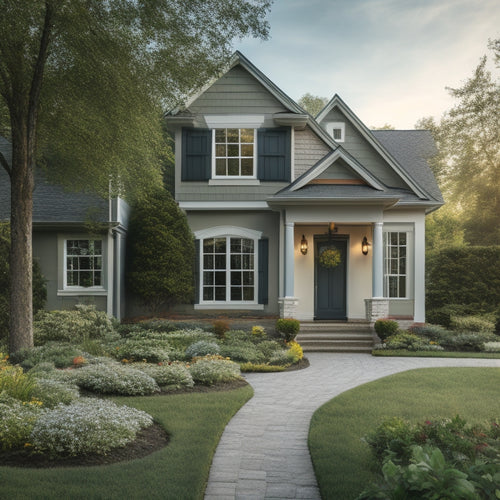
Estimating Construction Material Costs for Your Home Renovation
Share
When estimating construction material costs for your home renovation, you'll need to take into account the prices of cinder blocks, mortar, grout, sand, and aggregate, which can vary depending on the type, quantity, and quality. Cinder blocks, for instance, can range from $1 to $5 per block, with an average cost of $2 to $3. Mortar and grout costs differ based on type and application, while sand and aggregate prices depend on the type and quantity needed. By accurately calculating the quantity of each material and factoring in labor costs, you'll be better equipped to budget for your project. Now, let's break down each material cost in more detail to guarantee your renovation stays on track.
Key Takeaways
• Determine material costs by considering factors like quantity, structure size, and wall thickness for cinder blocks, mortar, and grout.
• Calculate labor costs for block laying based on block type, quantity, and wall layout complexity, as well as the mason's expertise level.
• Accurately calculate block quantity by considering wall area, block size, and wall height to prevent budget overruns and project delays.
• Factor in regional cost variations for materials, as prices can vary significantly depending on location, demand, and transportation costs.
• Allocate a contingency fund for unexpected expenses, such as hidden structural issues, material price fluctuations, and unforeseen site work.
Understanding Cinder Block Prices
When building a structure that requires a strong foundation or walls, you'll likely need to account for the cost of cinder blocks, which can vary depending on the region, supplier, and type of block.
Cinder block prices can range from $1 to $5 per block, with an average cost of around $2 to $3 per block. However, the overall cost will also depend on the quantity you need, which can be affected by factors like the size of your structure, the thickness of the walls, and the type of construction.
It's crucial to take into account the durability and insulation properties of the cinder blocks you choose. High-quality blocks with better insulation can provide long-term energy savings and reduce your carbon footprint.
Look for blocks with a high R-value, which measures their ability to resist heat flow. Additionally, take into account blocks with a high compressive strength, which guarantees they can withstand heavy loads and harsh weather conditions.
Calculating Block Quantity Needed
When calculating the quantity of blocks needed for your construction project, you'll need to take into account the size and shape of the blocks, as these factors greatly impact the overall quantity required.
You'll want to determine the total square footage of the area to be built, taking into consideration any corners, curves, or irregular shapes.
Block Size and Shape
You'll need to calculate the total number of blocks required for your construction project by considering the block size and shape, as these factors markedly impact the overall material quantity. The block dimensions and shapes you choose will directly affect the quantity of blocks you need to buy. For instance, larger blocks will cover more surface area, reducing the overall number of blocks required, while smaller blocks will need to be purchased in larger quantities.
Here's a breakdown of common block sizes and shapes:
| Block Size | Block Shape |
|---|---|
| 8' x 8' x 16' | Rectangular |
| 10' x 10' x 20' | Square |
| 12' x 12' x 24' | Rectangular |
| 6' x 6' x 12' | Square |
When selecting block sizes and shapes, consider the specific requirements of your project, including the wall's height, length, and thickness. By choosing the right block dimensions and shapes, you'll guarantee you have the correct quantity of materials and avoid costly mistakes. Remember, accurate calculations are vital to staying within budget and completing your project on time.
Block Quantity Formula
Now that you've selected the ideal block size and shape for your project, it's time to calculate the total block quantity needed by applying a formula that takes into account the wall's dimensions and block specifications.
To do this, you'll need to know the wall's length, width, and height, as well as the block's dimensions, including its length, width, and height.
The formula to calculate the total block quantity is:
Total Blocks = (Wall Area / Block Area) x (Wall Height / Block Height).
For example, if your wall area is 100 square feet, your block area is 10 square feet, and your wall height is 10 feet, with a block height of 2 feet, you'll need approximately 50 blocks.
When choosing the right blocks for your project, consider factors like block durability and insulation properties to guarantee you're selecting the best option for your needs.
Cost of Mortar and Grout
How accurately can you estimate the cost of mortar and grout, crucial components in masonry and tile work, taking into account their varying types, quantities, and application methods?
To get an accurate estimate, you'll need to factor in the specific mortar types you'll need for your project. Common mortar types include Type S, Type N, and epoxy-based mortars, each with its own unique characteristics and price points. For instance, Type S mortar is suitable for most general masonry applications, while epoxy-based mortars are ideal for high-strength, high-traffic areas.
When it comes to grout, you'll need to reflect on the color and type you want to use. Grout colors can range from basic white and gray to more decorative options like metallic and glass-based grouts.
You'll also need to decide on the grout's consistency, which can affect its spreadability and overall performance. With so many options available, it's important to research and compare prices to get the best value for your money.
Sand and Aggregate Costs
When estimating sand and aggregate costs, you'll need to take into account the types of sand required for your project, as different types have varying prices.
You'll also need to accurately calculate the quantity of aggregate needed, taking into account factors like the specific application and desired strength.
Types of Sand Needed
You'll need to specify the type of sand required for your construction project, as different types of sand vary considerably in price and quality, affecting your overall sand and aggregate costs.
There are several sand types, each with its unique characteristics, uses, and price points. For instance, concrete sand, also known as builder's sand, is a coarse, gritty sand used for mixing concrete and mortar. It's ideal for construction projects that require high-strength concrete, such as foundations, walls, and floors.
Play sand, on the other hand, is a finer, more compact sand often used in landscaping and playgrounds. It's a good choice for projects that require a smooth, even surface.
Masonry sand is another common type, used for laying bricks, blocks, and stones. It's typically finer than concrete sand and has a more uniform texture.
Understanding the different sand types and their uses will help you choose the right one for your project, ensuring you get the best value for your money. By specifying the correct type of sand, you'll avoid unnecessary expenses, delays, and potential structural issues down the line.
Aggregate Quantity Calculation
After selecting the appropriate type of sand for your construction project, you can proceed to calculate the aggregate quantity required, a critical step in estimating sand and aggregate costs.
To do this, you'll need to determine the volume of sand needed for each specific application, such as concrete, mortar, or plaster. Measure the dimensions of each area where sand will be used, and calculate the volume in cubic meters or yards. Consider the sand's density and moisture content, as these can affect the overall quantity required.
When calculating aggregate quantity, it's vital to factor in waste and contingencies. A general rule of thumb is to add 10-15% to your total calculation to account for unexpected losses or errors.
Next, research aggregate sourcing strategies to identify the most cost-effective suppliers and delivery options for your project. Will you opt for bulk delivery or smaller, more frequent shipments?
Labor Costs for Block Laying
Estimating labor costs for block laying requires a detailed understanding of the factors that influence the time and effort required to complete the task, including the type and quantity of blocks, wall layout, and the mason's level of expertise.
You'll need to take into account the specific block laying techniques used, as they can greatly impact labor efficiency. For instance, the use of mechanical scaffolding or specialized tools can increase productivity, while complex wall layouts or irregularly shaped blocks can decrease it.
When calculating labor costs, you'll need to determine the number of labor hours required to complete the task. This can be done by estimating the time it takes to lay a single block, then multiplying that by the total number of blocks needed.
Don't forget to factor in additional time for tasks like preparing the site, mixing mortar, and cleaning up.
Be sure to research local labor rates and adjust accordingly based on the mason's level of experience and the region you're in.
Additional Material Expenses
Additional Material Expenses
In addition to the cost of blocks themselves, your project's material expenses will also include the price of ancillary items like sand, cement, and mortar additives, which can add up quickly. These additional materials might seem minor, but they can account for a significant portion of your overall budget. It's crucial to factor them into your estimates to avoid hidden expenses that can blow your budget.
| Material | Average Cost |
|---|---|
| Sand (per ton) | $15-$30 |
| Cement (per bag) | $5-$10 |
| Mortar additives (per liter) | $10-$20 |
You'll also need to take into account the cost of other additional materials, such as reinforcement bars, wire mesh, and finishing materials like render, paint, or coatings. These costs can vary depending on the specific requirements of your project, but it's vital to include them in your estimates to get an accurate picture of your material expenses. By accounting for these additional materials, you can avoid costly surprises and guarantee your project stays on budget.
Regional Cost Variations
You must also consider how regional differences in material costs, supplier pricing, and local regulations can impact your project's bottom line.
As you research material costs, you'll find that regional pricing trends can vary greatly. For instance, lumber costs may be higher in areas with limited forests or high transportation costs. Similarly, regions with high demand for certain materials, such as concrete or steel, may drive up prices due to market demand fluctuations.
It's crucial to factor in these regional variations to guarantee your project stays within budget. Research local suppliers, builders, and contractors to get a sense of the going rates for materials in your area.
You can also consult online resources, such as construction cost indexes or regional pricing guides, to get a more accurate estimate of material costs. By accounting for regional cost variations, you can avoid costly surprises down the line and create a more realistic budget for your home renovation project.
Budgeting for Unexpected Costs
Construction projects often encounter unforeseen expenses, so it's vital to pad your budget with a contingency fund to absorb these unexpected costs. You'll want to allocate a percentage of your overall budget for an emergency fund to cover unexpected expenses that arise during the renovation process. This will help you avoid cost overruns and guarantee your project stays on track.
Here are three key reasons why budgeting for unexpected costs is essential:
-
Hidden structural issues: You may discover hidden structural issues that require additional repairs or replacements, adding to your overall cost.
-
Material price fluctuations: Material prices can fluctuate unexpectedly, resulting in higher costs than initially estimated.
-
Unforeseen site work: You may encounter unforeseen site work, such as removing hazardous materials or addressing unexpected soil conditions, which can add to your expenses.
Frequently Asked Questions
How Do I Ensure Accurate Measurements for My Construction Project?
When tackling a construction project, you'll want to ascertain accurate measurements to avoid costly mistakes.
Start by investing in reliable measurement tools, such as laser levels and digital calipers, to guarantee precise readings.
During project planning, double-check your calculations and consider creating a detailed mockup to visualize your design.
Can I Reuse Old Materials From My Existing Structure?
When considering reuse strategies, you'll want to conduct a thorough material assessment of your existing structure.
This involves evaluating the condition, quality, and functionality of materials like lumber, roofing, and flooring. You'll need to inspect for damage, rot, or decay, and determine what can be safely reused or repurposed.
Be sure to also check local building codes and regulations to guarantee compliance.
What Is the Average Cost of Construction Permits and Licenses?
'Ah, joy! More expenses to add to your renovation tally!
But seriously, you're probably wondering what's gonna set you back for permits and licenses. Well, buckle up!
The average cost of construction permits can range from 0.5% to 2% of your total project cost.
License fees? Those vary by state, county, or city, but expect to shell out around $500 to $2,000 for a permit application.
Get ready to part with some cash, friend!'
How Can I Minimize Waste During the Construction Process?
You're taking the right step by thinking about waste management during your construction project.
To minimize waste, you'll want to implement recycling strategies from the get-go. Start by identifying materials that can be reused or repurposed, like lumber or drywall.
Designate a waste sorting area on-site to separate recyclables from non-recyclables. Also, consider partnering with a waste management company that offers recycling services.
Are There Any Eco-Friendly Alternatives to Traditional Building Materials?
You're looking for eco-friendly alternatives to traditional building materials, and you're on the right track!
Sustainable materials can greatly reduce your carbon footprint. Consider using reclaimed wood, bamboo, or low-VOC paints.
For insulation, opt for green insulation like recycled denim or wool. These alternatives not only benefit the environment but also provide a healthier living space for you and your family.
Conclusion
As you stand amidst the rubble of your renovation, the final cost of construction materials coming into focus like a blueprint unfolding,
remember that accurate estimates are the foundation upon which your project's success is built.
Don't let hidden expenses topple your budget; instead, arm yourself with the knowledge to anticipate and prepare for every contingency,
ensuring your dream home rises from the dust, strong and unshakeable.
Related Posts
-

Streamlining Your Exterior Renovation Timeline
To streamline your exterior renovation timeline, start by identifying your project goals and objectives, and prioriti...
-

Why Renovation Waste Disposal Harms the Environment
When you undertake a renovation project, you're contributing to a staggering problem: renovation waste disposal, whic...
-

Budget-Friendly Materials for Your Home Renovation Needs
As you initiate your home renovation, you're enthusiastic to find budget-friendly materials that fit your vision with...


